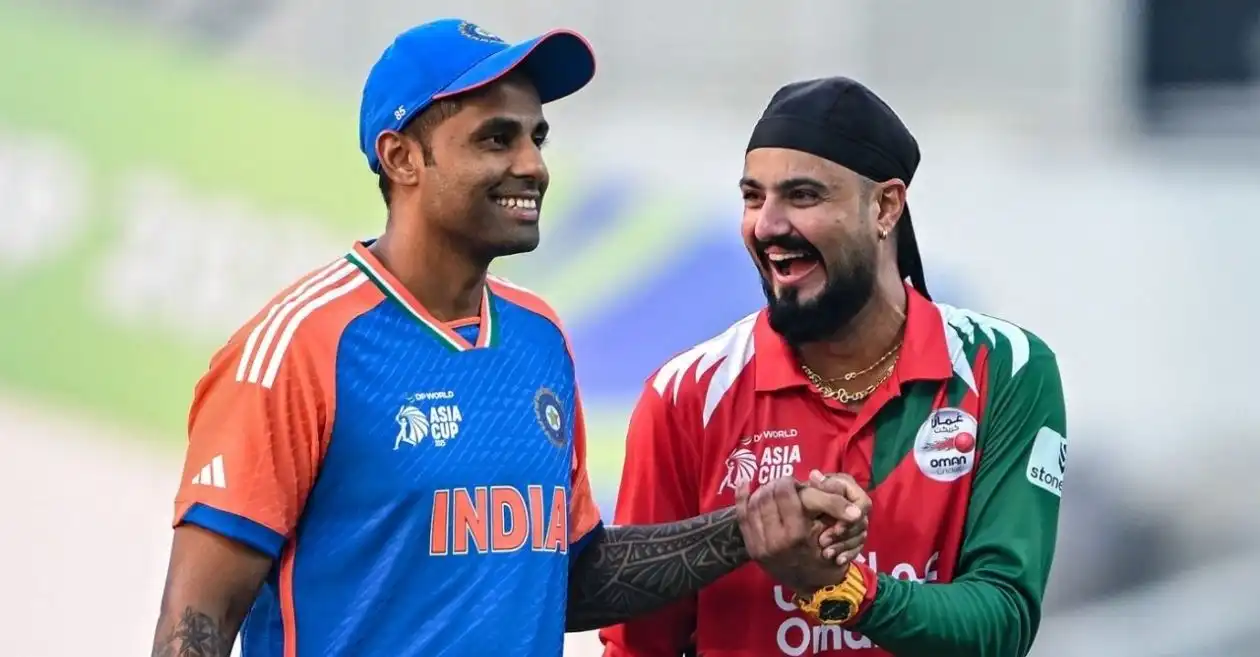In a tournament filled with big hits, breathtaking spells, and political undercurrents, one moment from India’s final Group A match in Asia Cup 2025 has stirred perhaps more debate than any innings or wicket: India captain Suryakumar Yadav did not come out to bat. Yes, even after eight wickets had fallen, even when it seemed there was time and necessity for every bat on the roster — he remained in the pavilion.
The decision has polarized opinion: some see it as a bold, strategic captaincy move, placing the team ahead of individual ego; others view it as an unnecessary gamble, perhaps disrespectful to fans, or even a dereliction of sorts of what a captain is “supposed to” do. The episode raises larger questions about captaincy, leadership, workload, and modern cricket’s evolving priorities.
Let’s unpack the context, the decision, the reactions, and what it might mean for the game’s future.
The Match & The Moment
-
Fixture: India vs Oman, Final Group A Game, Asia Cup 2025
-
Venue: Sheikh Zayed Stadium, Abu Dhabi
-
Result: India batted first, posted 188/8, and went on to defeat Oman by 21 runs.
-
Crucial Twist: Even though India used 10 batters — almost the full batting order — Suryakumar Yadav did not bat. He had been batting at #3 earlier in the tournament.
This was India’s last game before the Super 4s. With qualification already secured, the pressure of points was off. But for the squad, there was still value in momentum, in form, and in match practice.
Possible Rationales Behind the Move
Several factors seem to converge in explaining why Suryakumar Yadav chose (or was instructed) not to bat:
-
Rotation & Workload Management
With more difficult games ahead (notably vs Pakistan), resting senior players or rethinking roles becomes a prudent measure. Jasprit Bumrah was rested in this match. -
Depth Building
India seemed to use this match as an opportunity to give time to members of the batting lineup who’d had little time in earlier fixtures. Letting players like Sanju Samson and others bat longer under match conditions helps sharpen their game. -
Strategic Experimentation
Captains sometimes rearrange batting orders or delay their entry to test versatility and resilience in other batters. Perhaps Suryakumar felt that his presence was not essential to take the scoreboard forward at that point, especially if the top order had done sufficiently. -
Match Situation
India’s innings total — 188/8 — indicates that there was collapse potential. Maybe the captain felt intervening might not change the outcome materially, whereas letting lower-order batters get exposure was valuable. -
Message of Team-First Leadership
In modern cricket, leadership isn’t just about always being visible. Sometimes it’s about making choices that look odd but underscore that the team comes before individual preferences.
The Reactions: From Praise to Puzzlement
The decision did not go unnoticed. Public commentary, pundits, former players—all had something to say.
Praise from Sunil Gavaskar
Cricketing legend Sunil Gavaskar defended the move — calling Suryakumar an “innovative thinker”. He suggested that such decisions might only appear strange until the larger purpose is understood. Gavaskar pointed out that Suryakumar’s rotation of batsmen or dropping himself down the order is similar in spirit to other captaincy gambits — trusting the bench, resetting roles, freeing pressure from certain players.
Gavaskar said:
“If he had batted for even one over … but maybe he thought he didn’t need it. He is unorthodox. He sends in others. He thinks ahead.”
His support emphasizes that some cricket minds see merit in sometimes not doing what tradition demands.
Critiques (Including from Rohan Gavaskar)
Not everyone agreed. Sunil’s son, Rohan Gavaskar, questioned the logic. His view: if Suryakumar is not going to bat, perhaps he should have simply rested entirely, giving a chance to someone else (like Rinku Singh) rather than tying up a batting slot and audience expectations.
The raise in voice from Rohan and parts of the media reflects a belief that certain norms—captains batting, fighting until the last—are intrinsic to the captain’s role, both from performance and symbolic perspectives.
Pros and Cons: Balancing the Scales
Let’s chart out what this decision gained India — and what it risked.
| Potential Upsides | Risks / Downsides |
|---|---|
| Gives batting time to less-used players (Sanju Samson, etc.) which boosts confidence and match awareness. | Public perception: fans and critics might read it as arrogance, lack of fight, or disrespect of tradition. |
| Helps preserve physical and mental freshness for the captain ahead of tougher matches (like vs Pakistan). | If the lower order collapses, the decision could backfire — missed runs or lack of depth exposed. |
| Shows leadership maturity — that captain doesn’t need to always do “the expected” to lead. | Might be demotivating for some players or seen as avoiding accountability. |
| Reinforces that India has depth and resilient bench strength. | Opportunities for other players (like Rinku) may be missed. Score could have been higher had a senior batter stepped in. |
What We Know (and What We Don’t)
There are certainties and unknowns:
-
What we know: India declared or finished with eight wickets down; Suryakumar Yadav did not bat. The batting order was shuffled and some middle/lower-order batters took more responsibility.
-
What we don’t know (officially): Whether this was Suryakumar’s idea, team management’s plan, or partly due to personal strategy or fitness. There’s no formal statement confirming that he “demoted” himself or that he was skipping batting to rest.
Context: How Captains Are Changing The Game
The incident is part of a larger trend in cricket (especially T20s and high-stakes tournaments) where:
-
Rotation policies are more accepted. Preserving stars, protecting them from burnout.
-
Players are viewed as squads, not fixed XIs. Depth is emphasized.
-
Captains are more flexible, sometimes putting team needs over personal statistics or visibility.
-
Match conditions / tournament phases affect decision-making: e.g., when qualification is secured, captains experiment more.
What It Tells Us About Suryakumar Yadav’s Captaincy
From this episode, some characteristics of Suryakumar’s leadership emerge:
-
Risk-taking / unconventional: He seems willing to break norms for perceived gain.
-
Prioritizing team over self: Willing to forgo personal batting time if team benefit is clearer.
-
Confidence in bench strength: Trusts that other batters can step up.
-
Tournament management: Understanding phases—when to conserve energy, when to push full throttle.
Voices Around the Decision
-
Sunil Gavaskar: Highly supportive, sees it as avant-garde leadership.
-
Rohan Gavaskar: Skeptical; thinks if not batting, might as well rest, or allow someone else to play.
-
Media & Fans: Mixed. Many appreciate the boldness; others critique that tradition and symbolism matter in a captain’s role.
-
Opposition / Oman: No major expressed concern; they saw the scoreboard and speeches, but match results overshadowed the controversy in their camp. (No major quotes surfaced.)
What This Move Might Mean Long-Term
-
Could set precedent: future captains might feel freer to skip batting if strategic.
-
Might change perceptions of captaincy: from “always present with bat” to “present where needed.”
-
Could influence selection slots: if captains drop themselves, players below will need to be ready. Depth matters even more.
-
May shift fan expectations: cricket purists may resist, but many modern fans may see this as progressive.
India’s match against Oman did more than just add another victory to their Asia Cup record. It offered a glimpse of captaincy in flux—a leadership that is increasingly strategic, experimental, and team‑oriented. Suryakumar Yadav’s decision not to bat, while controversial, forces the cricketing world to ask: what exactly is expected of a captain? Is it to always walk out, even when the moment offers little to gain and much to manage?
Sunil Gavaskar would say yes, but he also sees value in breaking routines. Rohan disagrees visibly. And the fans? Somewhere in between—they want tradition, but they also cheer ingenuity.
In a sport defined by centuries, wickets, and bowlers who swing it late, perhaps the real game is happening in moments like this—off the field, in leadership rooms, in split decisions that test norms. For now, Suryakumar Yadav’s move stands as an audacious footnote in Asia Cup 2025. And whether it ages well or not will depend on how India plays in the hard games to come.
Please check for information on the best betting sites in India – https://selectory.org/best-betting-sites/















